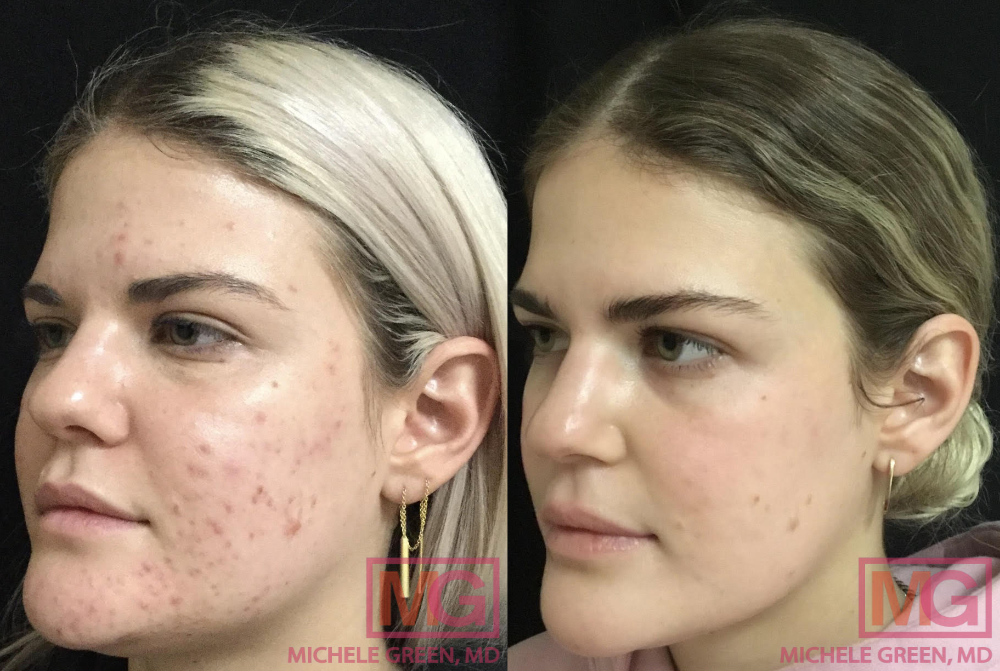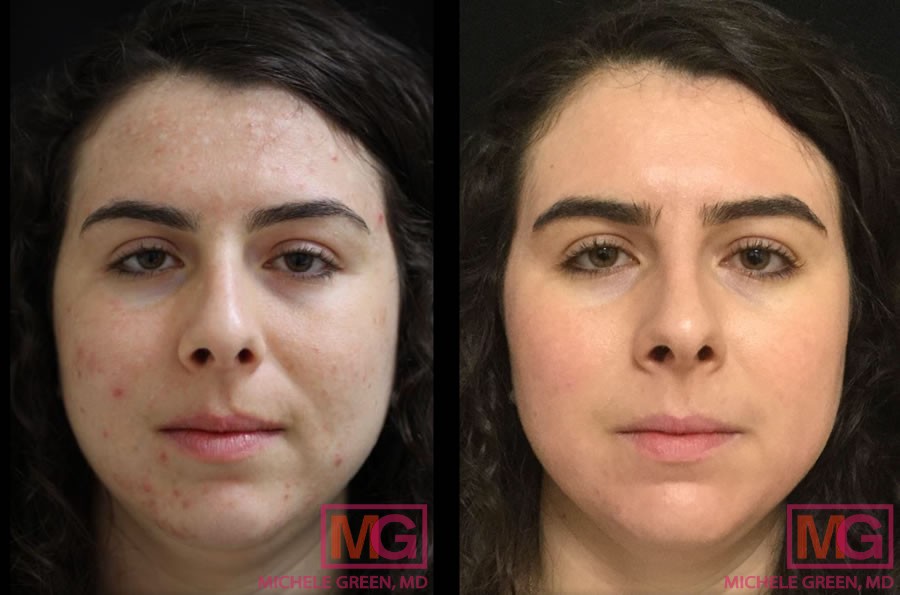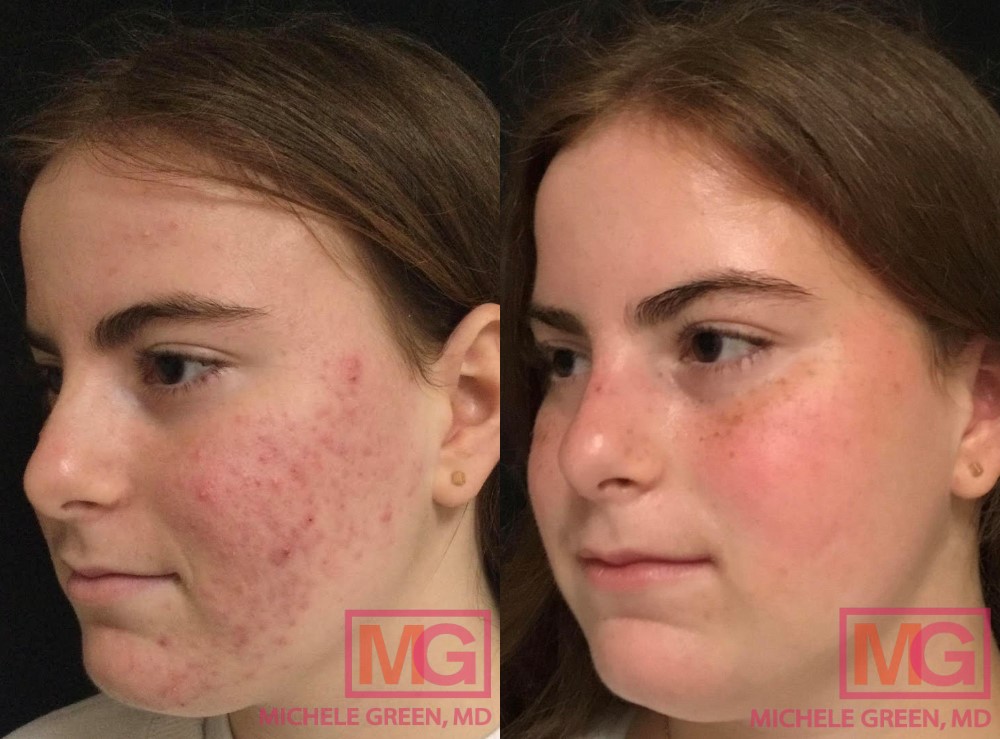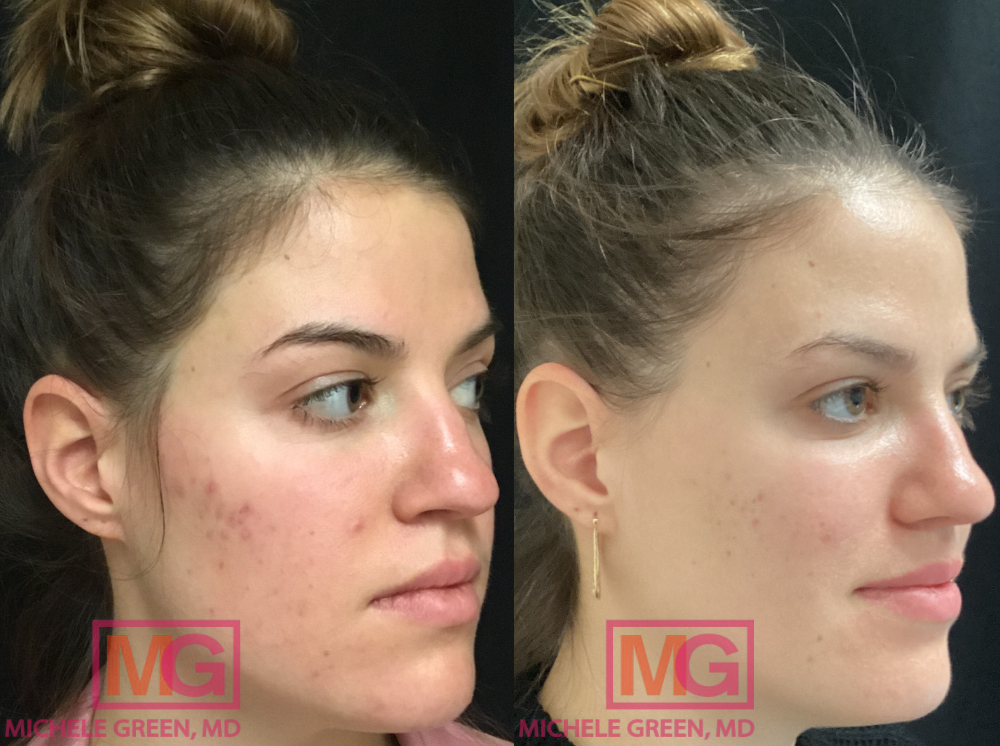What is Comedonal Acne?
Acne vulgaris is one of the most common skin conditions in the United States, affecting as many as 50 million Americans each year, according to the American Academy of Dermatology. Many people think about acne breakouts as affecting primarily adolescents during puberty; however, people of any age can experience pimples, blemishes, and acne lesions. While acne in itself is harmless, acne breakouts and blemishes can cause anxiety, feelings of frustration, and self-consciousness, leading patients to look for safe and effective acne treatment options. One of the critical components of effective treatment is identifying the type of acne you are dealing with and choosing the skin care products or procedures that will eliminate the breakout without making it worse. One of the most common forms of acne is comedonal acne, characterized by flesh-colored bumps that commonly form on the forehead and chin when excess sebum clogs the pores and hair follicles. Comedonal acne can be easily eliminated when you seek proper treatment from an expert, board-certified dermatologist, such as Dr. Michele Green in NYC.
There are several types of comedones that patients may experience during a breakout: closed comedones – also known as whiteheads – open comedones – also known as blackheads – microcomedones, macrocomedones, and giant comedones. Unlike other forms of acne vulgaris, such as papules, pustules, nodules, and cysts, comedones are not inflamed or infected with bacteria. Instead, they are characterized by individual comedos or clusters of comedones, which are usually small bumps that form on the skin’s surface in areas prone to high sebum production. There are many treatment options for comedonal acne, including topical treatments for unclogging the pores, decreasing sebum production, exfoliating dead skin cells, and promoting skin cell turnover, oil-free moisturizers, and creams to keep the skin hydrated. To discover the treatment plan that will work best for you, schedule your initial consultation with Dr. Michele Green in her Upper East Side New York City office.
Experienced, board-certified dermatologist Dr. Michele Green has been treating patients in her Upper East Side New York City dermatology office for more than 25 years. With her proprietary line of skincare products, MGSKINLABs, and years of treating all forms of acne, Dr. Green is an expert at creating individualized treatment plans to provide patients with clear, smooth, blemish-free skin. In addition to topical treatment options, Dr. Green is a master at many cosmetic procedures, including chemical peels, microdermabrasion, Botox, dermal fillers, laser treatment, and more. Applauded for her high patient satisfaction, Dr. Green has been voted one of New York City’s best healthcare providers by such publications as Castle Connolly, Super Doctors, and New York Magazine.
What is comedonal acne?
Comedonal acne is a form of acne characterized by tiny bumps close to the skin’s surface, leading to an uneven appearance. Commonly occurring in areas of the face where oil production is exceptionally high, such as the forehead and chin, comedonal acne lesions are typically skin-colored or slightly lighter than the surrounding skin. Comedonal acne differs from forms of inflammatory acne, such as papules, pustules, and cysts, because they do not contain bacteria and are not typically red or painful to touch. There are several different types of comedonal acne lesions, including closed comedones (whiteheads), open comedones (blackheads), macrocomedones, microcomedones, giant comedones, and solar comedones. Most often, comedonal acne occurs in clusters, though a single lesion is possible and is known as a comedo. There can be multiple types of comedones within a single breakout, ranging in size from macrocomedones, which are closed comedones that are bigger than 2-3 mm in diameter, to microcomedones, which are very small closed comedones that are usually difficult to see, to giant comedones, which are large open comedones with the characteristic blackhead. While comedonal acne breakouts are most common during puberty (14-17 years old for females and 16-19 for males), comedonal acne breakouts can occur at any time in life.
What are closed comedones (whiteheads)?
Closed comedones are a type of comedone acne characterized by small closed bumps caused by clogged pores or hair follicles. Closed comedones form when oil on the skin’s surface, called sebum, becomes trapped in pores or hair follicles and dead skin cells, dirt, or other debris. They are often slightly lighter in color than the surrounding skin, contributing to their alternate name of whiteheads, and appear in small clusters. They do not usually hurt to touch but can cause the skin to appear uneven in texture.
What are open comedones (blackheads)?
Open comedones, also known as blackheads, are another type of comedone acne that forms on the skin’s surface. Like closed comedones, open comedones are caused by a build-up of sebum and debris on the skin’s surface, which clogs the pores, leading to small bumps. The two types differ, however, in that open comedones are open pores rather than closed over. When the pores remain open, the oxygen in the air reacts with the melanin, or pigment, trapped in the pores, causing them to turn black. Many patients mistakenly believe that blackheads are dirt trapped under the skin’s surface and will try to clean the face using harsh topical products. This can worsen symptoms of an acne breakout and irritate the skin, which is why it is essential to consult with an expert dermatologist, such as Dr. Green, to achieve the best acne treatment results.

Skincare for comedonal acne
One of the best ways to treat and prevent comedonal acne is to create a skincare routine with gentle, non-comedogenic products to balance out the oil production and keep the skin adequately moisturized. The first step of any skincare routine is to use a gentle cleanser twice a day – once in the morning and once at night before bed – to keep the face clean and free of excess oil and debris. There are many over-the-counter cleansers available that are non-comedogenic and non-irritating to clean the skin without causing damage to the pores. Dr. Green recommends looking for AHA or BHA-based cleansers for acne-prone skin, which contain glycolic acid, salicylic acid, or azelaic acid. Studies have shown that cleansers containing these products can help to decrease the risk of developing both inflammatory and non-inflammatory acne.
The next step of your skincare routine should be to apply any topical acne treatments recommended to you by Dr. Green. For treating comedonal acne, Dr. Green will typically recommend a topical solution that will boost skin cell turnover and unclog the pores, such as over-the-counter creams containing benzoyl peroxide or prescription topical retinoids, such as Differin, Adapalene, retinol, isotretinoin, or tretinoin. These topicals increase the rate of skin cell turnover, sloughing away dead skin cells to reveal healthy, new skin cells. Retinoids can help keep the pores clear as well as improve overall skin texture and tone. Differin is available over the counter, whereas other retinoids are only available by prescription. Benzoyl peroxide is a valuable product for drying out the skin to reduce excess sebum and the presence of acne-causing bacteria. Topical retinoids, derived from vitamin A, work well to increase skin cell turnover to unclog the pores, reduce inflammation, and dry out oily skin.
Patients should also always apply a light, fragrance-free moisturizer to their daily skincare routine to hydrate the skin. Some patients with oily skin worry that moisturizers will make their skin more oily, but it is the opposite. The sebaceous glands produce excess oil when the skin is dry and flaky, so it is essential to keep the skin hydrated with a light, gentle moisturizer. Topical acne treatment products can also dry out the skin, necessitating a consistent moisturizer. The last step of every skincare routine should be the application of sunscreen of at least SPF 30 to protect the skin from sun damage. Sun exposure can dry out the skin, leading to excess sebum production, making sun exposure a significant risk factor for developing comedonal acne.
Where do comedones appear most frequently?
Comedones form when excess sebum and debris on the skin’s surface clog the pores and hair follicles. As such, comedones form most frequently on the oiliest parts of the skin, which most commonly includes the face, mainly the forehead and chin. While the face is the most common location for comedonal acne, breakouts can also happen on the chest and back.
Why does comedonal acne happen?
Comedonal non-inflammatory acne forms due to clogged pores, usually with sebum, dead skin cells, and other debris from the skin’s surface. Several risk factors can contribute to the formation of comedonal acne, including:
- Hormone fluctuations leading to increased production of testosterone and over-activation of the sebaceous glands
- Skin irritation from the use of certain products, such as oils and dyes
- Rough exfoliation or damage to the skin, including chemical peels and popping pimples
- High humidity or moisturizers that are too heavy that over-hydrate the skin
- Smoking
- Consuming a diet high in sugar, dairy, and carbohydrates
- Stress leading to hormone fluctuations
Comedonal acne can be prevented by practicing a healthy skincare routine and adjusting to avoid triggering products or environments.

Are closed comedones acne?
Closed comedones are a type of acne that forms due to clogged pores. These blemishes are non-inflammatory acne, meaning they are not typically infected with bacteria, nor are they filled with pus or painful to the touch. Closed comedones, also known as whiteheads, differ from open comedones in that the pores are completely closed, giving them a lighter color than the surrounding skin. Whiteheads can range in size from microcomedones, which are nearly invisible, to macrocomedones, which can be as large as 3 millimeters in diameter. While they are not inherently harmful, closed comedones can be frustrating for patients, creating an uneven texture to the skin. Luckily, they are relatively easy to treat with topical acne treatments such as benzoyl peroxide and topical retinoids.
How to know if you have comedonal acne
Comedonal acne is characterized by small bumps on the skin’s surface that can be open (blackheads) or closed (whiteheads). You may notice these bumps appearing in clusters with whiteheads and blackheads or as individual comedos. There are many over-the-counter products available to treat comedonal acne, but it is always best to consult with an expert dermatologist, such as Dr. Green, before beginning treatment. Dr. Green is highly experienced in identifying different types of acne and creating treatment plans that will address each patient’s specific needs.
Do comedones turn into pimples?
Pimples, or pustules, are inflammatory acne often filled with pus. Similarly to whiteheads, pimples are characterized by a white top; however, they differ from whiteheads in that the bumps are typically red, inflamed, and painful to touch. Pimples form when a clogged pore becomes clogged with bacteria, sebum, and debris. If acne-causing bacteria becomes trapped in a clogged pore, comedones can turn into pimples. Patients must not attempt to pop pimples at home as the bacteria and pus released from the lesion can damage the skin, infect other pores, and lead to acne scarring.

Do comedones go away on their own?
Patients often wonder, do comedones go away? The answer is that comedones are easy to treat and prevent with a good skincare routine and products such as topical retinoids. Some patients may try natural remedies that can reduce acne breakouts, such as products containing aloe vera gel, honey, or tea tree oil, which has anti-inflammatory and anti-bacterial effects. It is also essential to keep the skin clear of excess oil and debris, which necessitates a gentle, non-comedogenic cleanser. Cleansers containing salicylic or glycolic acid help reduce and prevent comedonal acne breakouts. Topical retinoids can also be applied to the lesions to increase skin cell turnover and clear the pores by drying out the treatment area. If these at-home treatment options do not eliminate the breakout, Dr. Green recommends an in-office procedure, such as microdermabrasion, to clear the skin.
Why is my comedonal acne getting worse?
There are several reasons why comedonal acne may be getting worse. To start, some people mistake blackheads as dirt under the skin, causing them to attempt to remove the debris with exfoliants. However, harsh exfoliation can irritate the skin’s surface, causing symptoms of comedonal acne to worsen. Diet and other lifestyle choices, such as smoking, can also be a risk factor for the development of comedonal acne, increasing sebum production in the body. Hormone fluctuations from puberty, pregnancy, or stress can also play a role in the development of comedonal acne, triggering the over-production of sebum and contributing to clogged pores.
What is a comedone on the face?
Comedones are acne that forms frequently on the face, mainly the forehead and chin, where there is a higher density of sebaceous glands and oil production. Excess oil on the skin’s surface can clog the pores and hair follicles, leading to the formation of tiny bumps, creating an uneven skin texture on the face. Comedones on the face can be treated with topical solutions, including cleansers, creams, and gels containing glycolic acid, salicylic acid, azelaic acid, and benzoyl peroxide, or with topical retinoids, such as retinol and tretinoin.
Does accutane help comedonal acne?
Accutane, the brand name for the retinoid known as isotretinoin, is an effective treatment option for comedonal acne if other treatment methods are not working. An oral medication, Dr. Green will typically prescribe accutane if topical retinoids or other in-office treatment methods are insufficient for clearing the acne breakout. The medication works to reduce sebum production in the sebaceous glands and eliminate acne-causing bacteria. A powerful treatment option, studies have shown that Accutane reduces acne breakouts in 95% of patients over the five-month course of the drug.

Are comedo extractors safe?
Comedo extractors are a device that can be applied to a comedonal acne breakout to clear the pores mechanically. While these devices are available over-the-counter for use at home, it can be harmful for your skin to perform this treatment on your own. It is best to have comedo extractions performed in the office of a board-certified dermatologist, such as Dr. Green. There is a proper method for ensuring safety with the device, and a dermatologist like Dr. Green has the training, knowledge, and experience required to employ it. Using a comedo extractor at home can increase your risk of acne scars, skin irritation, and worsening the existing breakout. https://www.ncbi.nlm.nih.gov/pmc/articles/PMC3225139/
Hydrafacials and Comedonal acne
A Hydrafacial is a three-step medical-grade facial that exfoliates, cleanses, and nourishes the skin to improve its overall health and appearance. The Hydrafacial is performed using innovative vortex tip suction technology to achieve healthier, clearer, more radiant skin powerfully yet gently. Hydrafacial treatment involves intensely cleansing and then exfoliating the skin’s surface by removing dead skin cells to reveal healthy skin. The Hydrafacial extracts dead skin cells, debris, and sebum from pores, which can help treat and prevent comedonal acne. Once your pores have been cleared, your skin is infused with antioxidants and hydrating serums, which leave your skin glowing and bright with immediate and lasting results. Most patients with comedonal acne have Hydrafacial treatments on a monthly basis until their skin condition resolves, after which their complexion can be maintained with quarterly Hydrafacial treatments. When you consult with Dr. Green at her private dermatology office in Manhattan’s Upper East Side neighborhood, she will work with you to develop a treatment plan for your comedonal acne and a timeline for your Hydrafacials that best suits your needs.
How to get started with comedonal acne treatment today
Comedonal acne is characterized by tiny bumps on the skin’s surface due to clogged pores and hair follicles. There are two main types of comedonal acne – closed comedones and open comedones – that differ in whether the pores are closed over or open to the environment. Comedones can vary in size from practically invisible to several millimeters in diameter. While they are not particularly painful, comedones can create a bumpy texture to the skin, leading to stress and anxiety about their appearance. Luckily, there are many treatment options available at Dr. Green’s NYC dermatology office to eliminate comedonal acne breakouts. From helping you choose products for your daily skincare routine to prescribing retinoids to fight an active breakout, Dr. Green can create a treatment plan to keep your skin smooth, clear, and bright.
Dr. Michele Green is an internationally renowned board-certified dermatologist with over two and a half decades of experience providing some of the world’s most discerning individuals with the best non-invasive treatment options, including for comedonal acne. Dr. Green takes a holistic approach, customizing each patient’s treatment plan to suit their particular needs best. She is consistently identified as one of NYC’s best dermatologists for her dedication to her patients and expertise. When you consult with Dr. Green, she will collect a thorough medical history, review any previous treatment options you’ve tried, and physically assess your skin condition to develop a personalized plan for achieving and maintaining clear, smooth, healthy skin. Please call us at 212-535-3088 or email our New York City-based office today to schedule a consultation with Dr. Michele Green and discover which acne treatment is best for you.
 212-535-3088
212-535-3088